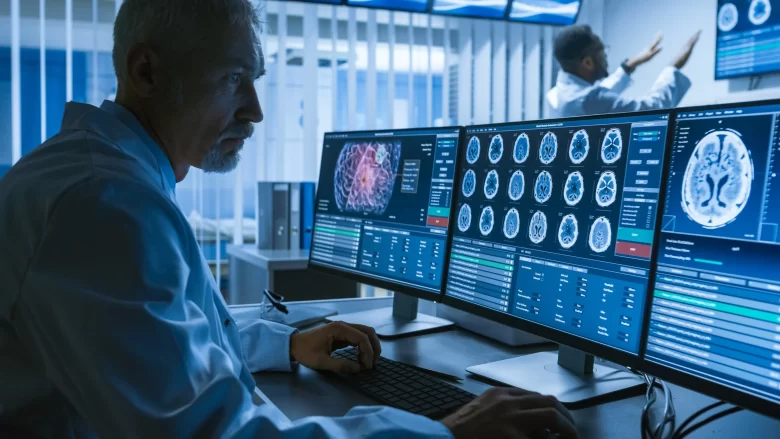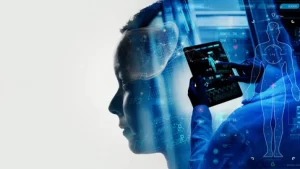Magnetic resonance imaging (MRI) is an important tool in medical diagnosis because it allows doctors to see clearly inside body structures without harming the patient. Brain diseases, spinal cord injuries, cancer and heart disease are just some of the conditions that this technology is important to detect. But because MRI data is so complex, it takes a lot of time and knowledge to analyse it correctly. This creates major problems for medical imaging. Artificial intelligence (AI) has emerged as a game-changing answer, making MRI analysis faster, more accurate and overall more useful.
The Role of AI in MRI Analysis:
Faster Image Acquisition: Regular MRI procedures can take a long time and patients often have to lie still for long periods of time. This can be difficult for children or people who are afraid of being crushed. Artificial intelligence systems are developing increasingly faster ways to acquire images, significantly reducing scan times. This not only makes patients more comfortable but also speeds up the MRI machines, allowing more people to use them.
Better Image Reconstruction: The role of artificial intelligence in better image reconstruction is very new. With conventional MRI, data is often missing or noisy, deteriorating image quality. Artificial intelligence algorithms can figure out what this less-than-ideal data means and use it to create a clear, detailed picture that makes diagnosis easier. This skill is useful when using smaller doses of contrast agents, reducing the risk of side effects for the patient.
Precise Image Segmentation: It is important to be able to distinguish the differences between different types of tissue and notice abnormal changes in MRI scans. Artificial intelligence is very good at segmenting complex images and accurately distinguishing healthy tissue from abnormal tissue. This level of accuracy is important in many areas of medicine, especially cancer, neurology and cardiology, where an an an early and correct diagnosis can have a significant impact on the effectiveness of treatment.
Better Diagnostic Accuracy: Reading MRI images is a very difficult task and people can make mistakes when they are tired or rely on their own judgement. Radiologists can get a lot of help from artificial intelligence learned on large data sets. Artificial intelligence can reduce the chance of making an incorrect diagnosis and ensure that results are more consistent and correct by providing a second opinion, pinpointing suspicious areas and even suggesting possible diagnoses.
Planning a Personalised Treatment Plan: Artificial intelligence has also had a major impact on personalised medicine. Because AI can look at large, complex records, it can discover unique characteristics of a disease, helping doctors find more effective treatments. This adjustment to the drugs makes them more effective and smaller, leading to better outcomes for patients.
Challenges and Future Directions:
The application of artificial intelligence in MRI research has great potential, but there are also some problems. A major concern is the accuracy and dependency of AI systems, especially when it comes to ensuring they can work with a wide range of patients and devices. When AI is trained on unrepresentative data sets, bias can occur, and fixing AI bias is important to ensure that the results are fair and correct.
Another question is how we can make AI tools work well with the way clinical work is already done. Healthcare workers need to learn how to effectively understand and use the output of artificial intelligence. Additionally, AI systems must be easy to use and work with existing medical record systems.
Regulatory hurdles and data privacy and security issues must be carefully negotiated. Ensuring that patient data is used fairly and securely is important for maintaining public trust and complying with the law.
Artificial intelligence will play an important role in future MRI processing. We can expect AI algorithms to improve, making research faster and more accurate. Artificial intelligence can not only help with diagnosis but can also predict how a disease will develop and how a person will respond to treatment. This could change the way personalised medicine is practiced.
Artificial intelligence can also be more deeply integrated into daily healthcare work. As AI tools become more accessible and easier to use, they may become a standard part of the diagnostic process alongside more traditional modalities.
Conclusion:
Adding artificial intelligence to MRI processing is an important step toward improving medical imaging. AI makes MRI analyzes faster, more accurate and more efficient. This improves patient care and opens the door to new research and treatments. As artificial intelligence technology advances, it will play a greater role in nuclear magnetic resonance research. This will further transform the field of diagnostic imaging and lead to new ways to deliver personalized care to patients. MRI, which combines artificial intelligence and human knowledge, is not only an improvement on existing technology, but also a huge step towards future medical diagnoses.



